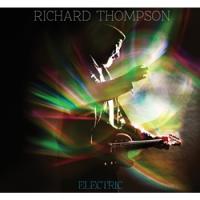Richard Thompson's "Electric" Continues Celtic Mayhem Chronicles
Long time fans will find the familiar as discomforting and comfortable as ever. The songs are littered with Thompson's clever couplets and backed by his barbed wire electric guitar though despite the album title there's some acoustic work here as well.
Thanks to his inventive energy and a wide variety of production backdrops Thompson has managed throughout his forty plus year long solo recording career to make the familiar formula sound fresh and inviting. Here he turns in nearly a dozen originals, not a one of which could be described as filler. He can merge humor and violence and have you laughing and repulsed all in a single image.
Side one of this four sider covers: a toothless peeping tom (roughed up by "a pair of gorillas from the London Zoo." Though he's "dripping with blood, dripping with snot, he's still dreaming of her you-know-what,") a one night stand filled with regrets, a cynical politician and a working slob's tough life.
If you're looking for relief on side two, forget it. It opens with a song about enemy co-dependency, moves on to betrayal and paranoia, then rootlessness and ends with one of Thompson's most heartfelt break-up tunes (though tinged with his patented bitterness) that chronicles the protagonist's wife packing up her bags and walking out with the kids.
Side three covers temptation, regret and on "Snow Goose", the standout track on the side (perhaps because of its acoustic arrangement), a disorienting look at confusion, tentativeness and rejection with a haunting Alison Krauss backdrop. The side ends finally, with some redemption and comfort with wonderful harmonies from Siobhan Kennedy and a sweeping fiddle part from Stuart Duncan. Whew! It took three sides to get there.
This is a sharply drawn album that shines a halogen light on the dark side of life. You'll see yellow street lights, factory walls and tear drenched cobblestones.
Side four contains four of the deluxe CD's seven bonus tracks and like most bonus track collections they are not essential to the album's flow but as with most things Richard Thompson, nor are they by any means throwaways or rejects.
Yes, the subject matter can take you low but the energy level is high and Thompson's playing, driven by his strong longtime backing of Taras Produniak on bass and manocello and Michael Jerome on drums augmented by producer Buddy Miller and others, is as sharp and edgy as ever.
The recording was done to 16 track analog tape at Buddy Miller's studio and it sounds as if much of it was laid down live with lots of room sound thrown into the mix to produce a coherent stage filled with well-focused images and a minimum of studio artifice.
I had the CD here for weeks before the arrival of the double LP set, mastered by George Ingram at Nashville Record Productions, though the actual cut was accomplished by Wes Garland. As I suspected, though the record was recorded analog to 16 tracks, it was mixed to digital and it sounded on the CD as if plenty of dynamic compression had been applied. The sound on CD had the dark ProTools balance that removes the sparkle and air from cymbals and dulls transient snap, though the overall effect was pleasing and very listenable.
Mr. Garland told me that the record was cut using the 88.2/24 bit pre-mastered file but he also told me that out of concern for the vocal sibilants he felt it necessary to cut at reduced level. Given that this was pressed at United, I worried about noise but the records were commendably quiet and very well pressed. Note to URP: MORE LIKE THIS PLEASE!
Considering that there were four sides to work with, it's too bad Mr. Garland was concerned about the playback needs of people with cheap turntables. I don't think they'll be buying this vinyl! Please cut records for the best playback scenario.
You'll need to turn up the volume to get the life flowing from this record and even then it's a mixed bag though mostly a good one as long as you're not expecting Henry The Human Fly—like clarity, dynamics, imaging and drum kit sparkle because you ain't getting it despite the analog raw material starting point.
The drums in particular are soggy, squooshy and indistinct and overall dynamics suffer compared to the CD—and the CD is not exactly a dynamic powerhouse. The record betters the CD in terms of three-dimensionality and particularly guitar textures thanks in part to the 24 bit file resolution used to produce the record.
The acoustic number "Snow Goose" in particular sounds far better on record thanks in no small part to very quiet vinyl (and the sibilants weren't close to unhinging my or any decent analog rig), but despite the analogue beginnings I'm afraid this can't be considered a sonic standout. Still I'll take warm and somewhat murky every day over icy and cold.




